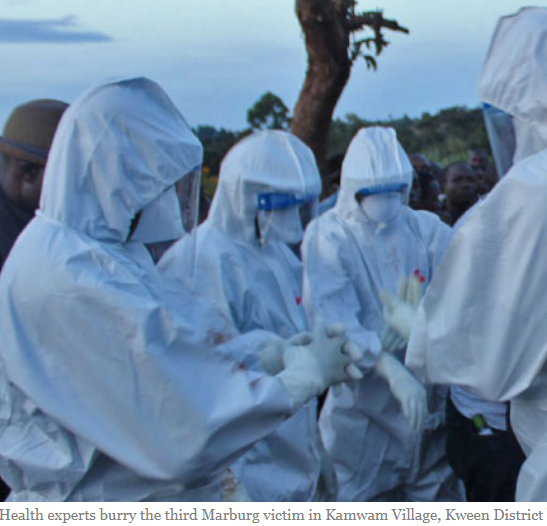Government said on Friday it had successfully contained an outbreak of the Marburg virus, a highly infectious haemorrhagic fever announced by officials on Oct. 19, which killed three people.
Junior health minister Sarah Achieng Opendi told a news conference that all suspected persons tracked after the third death had completed 21 days of monitoring without showing any symptoms.
An extra 21 days of surveillance were observed as recommended by the World Health Organisation.
“We have completed 42 days since the death of the last confirmed case,” she said.
“The ministry of health is pleased to officially declare the country free from the Marbug viral disease.”
The outbreak had occurred in the country’s eastern region and the first victim was a hunter who prowled an area with bat-infested caves.
The African fruit bat is the reservoir host of the Marburg virus, a cousin of the more lethal Ebola, although infected bats do not show obvious signs of the disease.


Marburg hemorrhagic fever is a severe and highly fatal disease caused by the Marburg virus from the Filoviridae family; the same family as the Ebola virus. The virus is among the most deadly known to infect humans. The incubation period is two to 21 days, and symptom onset is sudden and marked by fever, chills, headache, and myalgia.
Although the disease is rare, it can result in large outbreaks with high fatality rates.
The disease is transmitted by direct contact with the blood, body fluids and tissues of infected persons or wild animals, including monkeys and fruit bats.
The first case was detected by the Ministry of Health on October 17, when a 50-year-old woman died at a health centre of fever, bleeding, vomiting and diarrhoea on October 11 in Kween District, a mountainous area 300 kilometres northeast of Kampala.
Laboratory tests at the Uganda Virus Research Institute in Entebbe confirmed the cause of death as Marburg.

The woman’s brother had also died of similar symptoms three weeks earlier and was buried in a traditional ceremony. He worked as a game hunter and lived near a cave inhabited by Rousettus bats, which are natural hosts of the Marburg virus.
Symptoms
According to Center for Disease Control and Prevention (CDC), around the fifth day after the onset of symptoms, a maculopapular rash, most prominent on the trunk (chest, back, stomach), may occur.
Other symptoms include: nausea, vomiting, chest pain, a sore throat, abdominal pain, and diarrhoea. Symptoms become increasingly severe and can include jaundice, inflammation of the pancreas, severe weight loss, delirium, shock, liver failure, massive bleeding and multi-organ dysfunction.
Marburg has symptoms that are similar to other infectious diseases such as malaria or typhoid fever and clinical diagnosis of the disease can be difficult, especially if only a single case is involved.
Prevention
Preventive measures against Marburg virus infection are not well defined, as transmission from wildlife to humans remains an area of ongoing research.
If a patient is either suspected or confirmed to have Marburg haemorrhagic fever, barrier nursing techniques should be used to prevent direct physical contact with the patient, according to CDC.
The precautions include wearing of protective gowns, gloves, and masks; placing the infected individual in strict isolation; and sterilisation or proper disposal of needles, equipment, and patient excretions.
The country had taken about three years without reporting any outbreak of a viral haemorrhagic fever. The last confirmed outbreak in the country happened in September 2014 when a 30-year old man died after testing positive of the Marburg virus.
Past outbreaks
2007: Four cases, including two deaths, in Ibanda District, Western Uganda.
2008: Two unrelated cases in travellers returning to the Netherlands and USA, respectively after visiting caves in Western Uganda.
2012: Fifteen cases, including four deaths, in Ibanda and Kabale districts, Western Uganda.
2014: One case of a healthcare professional from Mpigi District, Central Uganda.











